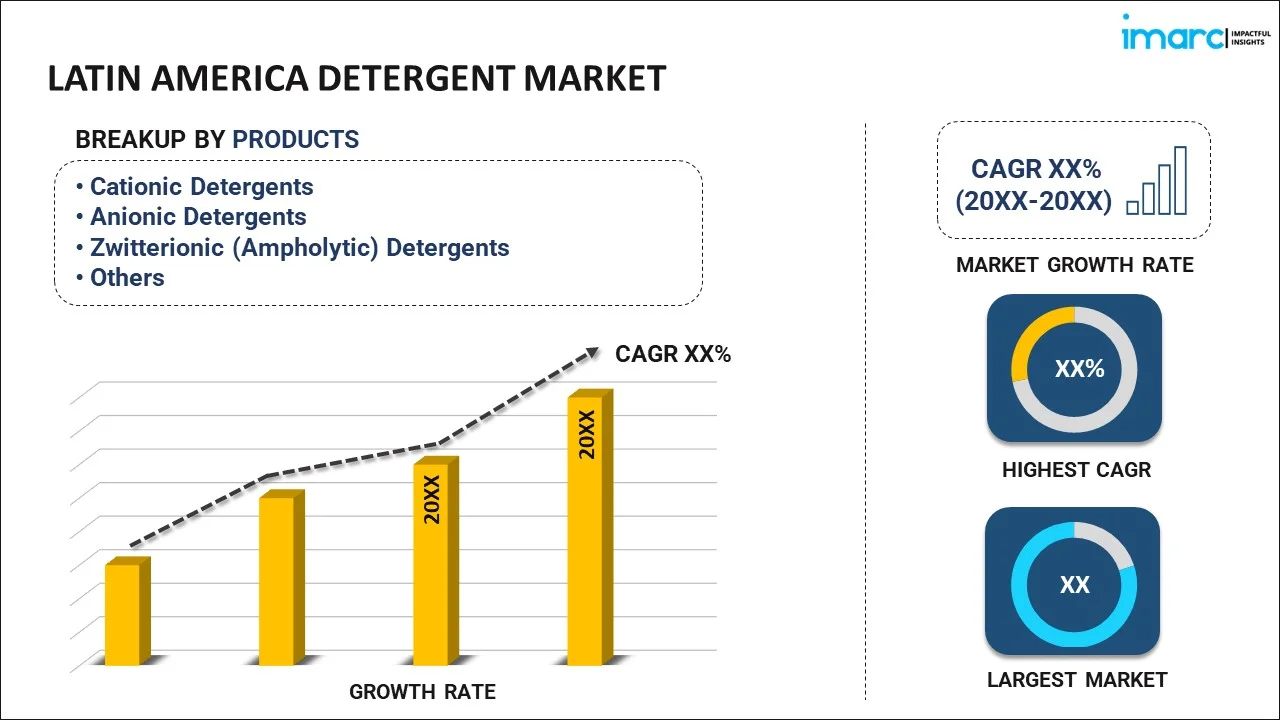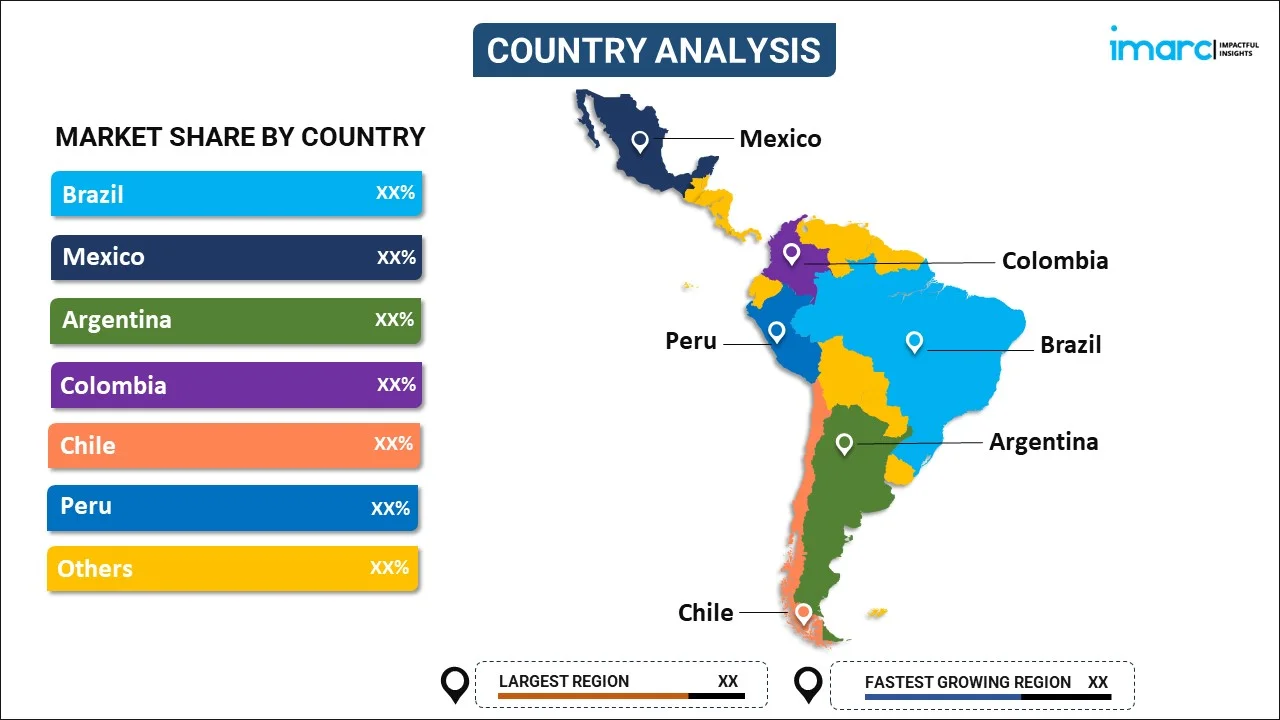
Latin America Detergent Market Report by Product (Cationic Detergents, Anionic Detergents, Zwitterionic (Ampholytic) Detergents, Non-ionic Detergents, Bio-based Cleaners), Form (Liquid/Gels, Powders, Tablets/Bars), Application (Food and Beverage Processing, Animal Hygiene, Laundry Care, Detergent Powders, Household Cleaning, Dishwashers, Personal Care, Fuel Additives, and Others), and Country 2025-2033
Market Overview:
Latin America detergent market size reached USD 2.9 Billion in 2024. Looking forward, IMARC Group expects the market to reach USD 4.1 Billion by 2033, exhibiting a growth rate (CAGR) of 3.40% during 2025-2033. The ongoing advances in detergent formulations and manufacturing technologies, which lead to the development of more effective and eco-friendly products, are primarily driving the regional market.
|
Report Attribute
|
Key Statistics
|
|---|---|
|
Base Year
|
2024
|
|
Forecast Years
|
2025-2033
|
|
Historical Years
|
2019-2024
|
|
Market Size in 2024
|
USD 2.9 Billion |
|
Market Forecast in 2033
|
USD 4.1 Billion |
| Market Growth Rate 2025-2033 | 3.40% |
Detergent is a cleaning agent commonly used in households and industrial settings to remove dirt, grease, and stains from various surfaces. It is a chemical compound that disrupts the surface tension of water, allowing it to penetrate and lift away unwanted substances more effectively than water alone. Detergents typically consist of a combination of surfactants, builders, and additives. Surfactants break down and emulsify oily or greasy substances, while builders enhance the detergent's effectiveness by softening water and preventing the re-deposition of soil onto cleaned surfaces. Additionally, additives may include enzymes for stain removal and fragrances for a pleasant scent. Detergents find extensive use in laundry, dishwashing, and general household cleaning, offering a versatile solution for maintaining cleanliness and hygiene in various environments.
Latin America Detergent Market Trends:
The detergent market in Latin America is experiencing robust growth, driven by several key factors. Firstly, the increasing awareness of hygiene and cleanliness among consumers has propelled the demand for detergents. Moreover, with the rising population and urbanization, there is a simultaneous surge in the number of households, contributing to the expanding consumer base for detergents. Additionally, the growing trend of dual-income families has resulted in a higher propensity to spend on convenience-driven products, further boosting the detergent market. Furthermore, the advent of innovative and eco-friendly detergent formulations has captured consumer attention, aligning with the prevailing sustainability trend. This shift towards environmentally conscious products is pushing manufacturers to invest in R&D, thereby fostering market growth. The prevalence of digitalization has also played a pivotal role, facilitating ease of product accessibility through online platforms and enhancing consumer awareness. In tandem with this, strategic marketing initiatives by key players, coupled with effective distribution channels, have propelled market penetration. In conclusion, a confluence of factors, including changing consumer preferences, sustainability concerns, and regional health crises, are serving as prominent drivers propelling the growth of the detergent market in Latin America.
Latin America Detergent Market Segmentation:
IMARC Group provides an analysis of the key trends in each segment of the market, along with forecasts at the regional and country levels for 2025-2033. Our report has categorized the market based on product, form, and application.
Product Insights:

- Cationic Detergents
- Anionic Detergents
- Zwitterionic (Ampholytic) Detergents
- Non-ionic Detergents
- Bio-based Cleaners
The report has provided a detailed breakup and analysis of the market based on the product. This includes cationic detergents, anionic detergents, zwitterionic (ampholytic) detergents, non-ionic detergents, and bio-based cleaners.
Form Insights:
- Liquid/Gels
- Powders
- Tablets/Bars
A detailed breakup and analysis of the market based on the form have also been provided in the report. This includes liquid/gels, powders, and tablets/bars.
Application Insights:
- Food and Beverage Processing
- Dairy Processing
- Meat Processing
- Beverage Processing
- Animal Hygiene
- Poultry
- Dairy Animals
- Pigs
- Pets
- Others
- Laundry Care
- Detergent Powders
- Detergent Cakes/Bars
- Laundry Liquids
- Fabric Softeners
- Monodose Packs
- Stain and Odor Eliminators
- Household Cleaning
- Floor Cleaners
- Glass Cleaners
- Ceramic Cleaners
- Wood Cleaners
- Dishwashers
- Personal Care
- Hair Care
- Skin Care
- Others
- Fuel Additives
- Others
The report has provided a detailed breakup and analysis of the market based on the application. This includes food and beverage processing (dairy processing, meat processing, and beverage processing), animal hygiene (poultry, dairy animals, pigs, pets, and others), laundry care, detergent powders (detergent cakes/bars, laundry liquids, fabric softeners, monodose packs, and stain and odor eliminators), household cleaning (floor cleaners, glass cleaners, ceramic cleaners, and wood cleaners), dishwashers, personal care (hair care, skin care, and others), fuel additives, and others.
Country Insights:

- Brazil
- Mexico
- Argentina
- Colombia
- Chile
- Peru
- Others
The report has also provided a comprehensive analysis of all the major regional markets, which include Brazil, Mexico, Argentina, Colombia, Chile, Peru, and Others.
Competitive Landscape:
The market research report has also provided a comprehensive analysis of the competitive landscape. Competitive analysis such as market structure, key player positioning, top winning strategies, competitive dashboard, and company evaluation quadrant has been covered in the report. Also, detailed profiles of all major companies have been provided.
Latin America Detergent Market Report Coverage:
| Report Features | Details |
|---|---|
| Base Year of the Analysis | 2024 |
| Historical Period | 2019-2024 |
| Forecast Period | 2025-2033 |
| Units | Billion USD |
| Scope of the Report | Exploration of Historical Trends and Market Outlook, Industry Catalysts and Challenges, Segment-Wise Historical and Future Market Assessment:
|
| Products Covered | Cationic Detergents, Anionic Detergents, Zwitterionic (Ampholytic) Detergents, Non-ionic Detergents, Bio-based Cleaners |
| Forms Covered | Liquid/Gels, Powders, Tablets/Bars |
| Applications Covered |
|
| Countries Covered | Brazil, Mexico, Argentina, Colombia, Chile, Peru, Others |
| Customization Scope | 10% Free Customization |
| Post-Sale Analyst Support | 10-12 Weeks |
| Delivery Format | PDF and Excel through Email (We can also provide the editable version of the report in PPT/Word format on special request) |
Key Questions Answered in This Report:
- How has the Latin America detergent market performed so far and how will it perform in the coming years?
- What has been the impact of COVID-19 on the Latin America detergent market?
- What is the breakup of the Latin America detergent market on the basis of product?
- What is the breakup of the Latin America detergent market on the basis of form?
- What is the breakup of the Latin America detergent market on the basis of application?
- What are the various stages in the value chain of the Latin America detergent market?
- What are the key driving factors and challenges in the Latin America detergent?
- What is the structure of the Latin America detergent market and who are the key players?
- What is the degree of competition in the Latin America detergent market?
Key Benefits for Stakeholders:
- IMARC’s industry report offers a comprehensive quantitative analysis of various market segments, historical and current market trends, market forecasts, and dynamics of the Latin America detergent market from 2019-2033.
- The research report provides the latest information on the market drivers, challenges, and opportunities in the Latin America detergent market.
- Porter's five forces analysis assist stakeholders in assessing the impact of new entrants, competitive rivalry, supplier power, buyer power, and the threat of substitution. It helps stakeholders to analyze the level of competition within the Latin America detergent industry and its attractiveness.
- Competitive landscape allows stakeholders to understand their competitive environment and provides an insight into the current positions of key players in the market.
Need more help?
- Speak to our experienced analysts for insights on the current market scenarios.
- Include additional segments and countries to customize the report as per your requirement.
- Gain an unparalleled competitive advantage in your domain by understanding how to utilize the report and positively impacting your operations and revenue.
- For further assistance, please connect with our analysts.
 Inquire Before Buying
Inquire Before Buying
 Speak to an Analyst
Speak to an Analyst
 Request Brochure
Request Brochure
 Request Customization
Request Customization




.webp)




.webp)












